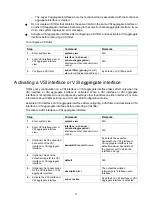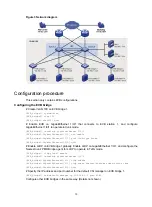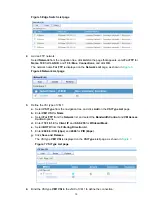
8
Configuring an S-channel interface or S-channel aggregate
interface
Step Command
Remarks
1.
Enter system view.
system-view
N/A
2.
Enter S-channel interface
view or S-channel aggregate
interface view.
interface
{
s-channel
|
schannel-aggregation
}
interface-number
:
channel-id
N/A
3.
(Optional.) Set the expected
bandwidth of the interface.
bandwidth
bandwidth-value
By default, the expected
bandwidth of an interface is the
default maximum bandwidth of
the physical port to which the
interface belongs.
4.
(Optional.) Restore the
default settings for the
interface.
default
N/A
5.
(Optional.) Set a description
for the interface.
description
text
The default description
information is "
interface name
Interface."
6.
Bring up the interface.
undo shutdown
By default, the interface is up.
Enabling the RR mode for an S-channel
EVB TLVs exchanged through LLDP allow an EVB station and EVB bridge to negotiate the RR mode.
If the EVB bridge supports the RR mode, when the EVB station requests the use of the RR mode, the
bridge performs the following operations:
•
Automatically enables the RR mode for the S-channel.
•
Saves the configuration in the configuration file on the bridge.
You can perform this task to manually enable the RR mode for an S-channel.
To enable the RR mode for an S-channel:
Step Command
Remarks
1.
Enter system view.
system-view
N/A
2.
Enter S-channel interface
view or S-channel
aggregate interface view.
interface
{
s-channel
|
schannel-aggregation
}
interface-number
:
channel-id
N/A
3.
Enable the RR mode for the
S-channel.
evb reflective-relay
By default, the RR mode is
disabled for an S-channel.
Disabling MAC address learning for an S-channel
Perform this task to manually disable the MAC address learning feature for an S-channel.
Follow these restrictions and guidelines when you disable MAC address learning for an S-channel:
•
For the bridge to successfully forward traffic for VMs on the EVB station, do not disable MAC
address learning on an S-channel with the RR mode disabled.












































